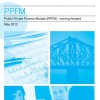This paper is the second in ACE’s infrastructure investment series and explores in more detail the rationale, performance and market conditions that surround Public and Private Finance Models (PPFM).
This paper explores a number of flexible models that should help to improve public and private sector performance. Whilst, encouraging the level of private finance required to improve the UK’s aging infrastructure. Importantly, improving the models through which private finance is encouraged into infrastructure investment is key to providing savings for the taxpayer.
- The PFI model is in need of review by government following the financial crisis. A number of factors have changed, such as the higher cost and lower availability of capital. This has in turn called into question value for money, the relative cost of the public sector undertaking the project and attracting further investment into primary (greenfield/new build) projects.
- However, the National Audit Office (NAO)3 has previously found that there are some positives that can be taken forward from the PFI miodel. For example:“Sixty nine per cent of PFI projects reported delivering to the contracted timetable in 2008.”“Ninety four per cent of projects responding to our 2008 survey were reported to have been delivered on, or less than five per cent over, price”
- There needs to be greater flexibility built within models to allow a more efficient application to a wider set of scenarios. The PFI model has shown that there is an interest from the private sector. Areas such as construction risk can be improved, the financial crisis and the subsequent shift in attitudes away from higher risk projects have highlighted the need for the model to be improved.
- This paper outlines five Public Private Finance Models (PPFM) that aim to improve the prospects of private financing, its performance and value for money going forward.
Company website:
http://www.acenet.co.uk/

